

Overjustification effect. The overjustification effect occurs when an expected external incentive such as money or prizes decreases a person's intrinsic motivation to perform a task.
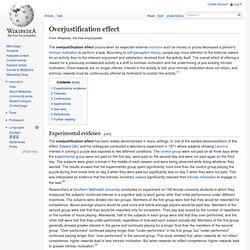
According to self-perception theory, people pay more attention to the external reward for an activity than to the inherent enjoyment and satisfaction received from the activity itself. The overall effect of offering a reward for a previously unrewarded activity is a shift to extrinsic motivation and the undermining of pre-existing intrinsic motivation. Once rewards are no longer offered, interest in the activity is lost; prior intrinsic motivation does not return, and extrinsic rewards must be continuously offered as motivation to sustain the activity.[1] Experimental evidence[edit] Researchers at Southern Methodist University conducted an experiment on 188 female university students in which they measured the subjects' continued interest in a cognitive task (a word game) after their initial performance under different incentives. Overjustification Effect. Explanations > Theories > Overjustification Effect Description | Research | Example | So What?
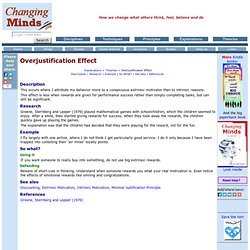
| See also | References Description This occurs where I attribute my behavior more to a conspicuous extrinsic motivator than to intrinsic reasons. This effect is less when rewards are given for performance success rather than simply completing tasks, but can still be significant. Research Greene, Sternberg and Lepper (1976) played mathematical games with schoolchildren, which the children seemed to enjoy. The explanation was that the children had decided that they were playing for the reward, not for the fun. Example I fly largely with one airline, where I do not think I get particularly good service. Priming (psychology) Priming can occur following perceptual, semantic, or conceptual stimulus repetition.
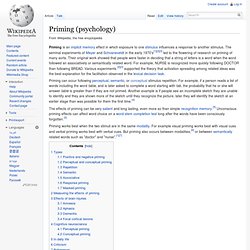
For example, if a person reads a list of words including the word table, and is later asked to complete a word starting with tab, the probability that he or she will answer table is greater than if they are not primed. Another example is if people see an incomplete sketch they are unable to identify and they are shown more of the sketch until they recognize the picture, later they will identify the sketch at an earlier stage than was possible for them the first time.[4] The terms positive and negative priming refer to when priming affects the speed of processing.
Negative priming is more difficult to explain. The difference between perceptual and conceptual primes is whether items with a similar form or items with a similar meaning are primed. Priming. Explanations > Theories > Priming Description | Research | Example | So What?
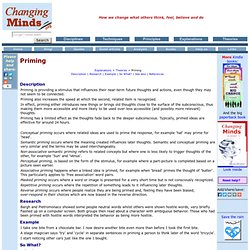
| See also | References Description Priming is providing a stimulus that influences their near-term future thoughts and actions, even though they may not seem to be connected. Priming also increases the speed at which the second, related item is recognized. In effect, priming either introduces new things or brings old thoughts close to the surface of the subconscious, thus making them more accessible and more likely to be used over less accessible (and possibly more relevant) thoughts. Priming has a limited effect as the thoughts fade back to the deeper subconscious. Conceptual priming occurs where related ideas are used to prime the response, for example 'hat' may prime for 'head'. Opponent-process theory.
Visual perception[edit] The opponent-process theory was first developed by Ewald Hering.
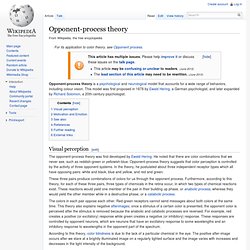
He noted that there are color combinations that we never see, such as reddish-green or yellowish-blue. Opponent-process theory suggests that color perception is controlled by the activity of three opponent systems. In the theory, he postulated about three independent receptor types which all have opposing pairs: white and black, blue and yellow, and red and green.
These three pairs produce combinations of colors for us through the opponent process. The colors in each pair oppose each other. According to this theory, color blindness is due to the lack of a particular chemical in the eye. Motivation and Emotion[edit] Richard Solomon developed a motivational theory based on opponent processes. Hurvich & Jameson proposed a neurological model of a general theory of neurological opponent processing in 1974. See also[edit] References[edit] Jump up ^ Solomon, R.L. (1980). Further reading[edit] ERN Grigg, MD. Opponent-Process Theory. Explanations > Theories > Opponent-Process Theory Description | Research | Example | So What?
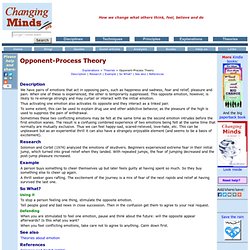
| See also | References Description We have pairs of emotions that act in opposing pairs, such as happiness and sadness, fear and relief, pleasure and pain. When one of these is experienced, the other is temporarily suppressed. Thus activating one emotion also activates its opposite and they interact as a linked pair. To some extent, this can be used to explain drug use and other addictive behavior, as the pleasure of the high is used to suppress the pain of withdrawal. Sometimes these two conflicting emotions may be felt at the same time as the second emotion intrudes before the first emotion wanes. Research Solomon and Corbit (1974) analyzed the emotions of skydivers. Example A person buys something to cheer themselves up but later feels guilty at having spent so much. A thrill seeker goes rafting. So What? Using it To stop a person feeling one thing, stimulate the opposite emotion.
Defending. Opponent Process Theory Defined - Psychology Glossary.